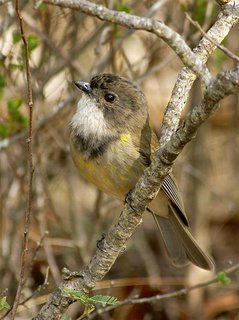 "The hills are alive with the sound of....Golden Whistlers". Well that about sums up my morning in the Meehan Range at Cambridge. Although I say "in", in fact I barely moved more than about 100 metres from the entrance. As I got out of the car, one of the more obvious bird calls were from a number of Golden Whistlers calling loudly. Despite a number of attempts to photograph them in the past, I hadn't managed a decent shot, so I set about trying to rectify that.
"The hills are alive with the sound of....Golden Whistlers". Well that about sums up my morning in the Meehan Range at Cambridge. Although I say "in", in fact I barely moved more than about 100 metres from the entrance. As I got out of the car, one of the more obvious bird calls were from a number of Golden Whistlers calling loudly. Despite a number of attempts to photograph them in the past, I hadn't managed a decent shot, so I set about trying to rectify that.Most of my birding over the years has rarely included sitting in one position and waiting, and I'm beginning to realise what I may have missed. As I waited for these whistlers to approach, I watched them feeding. Mostly they sat among the acacia (a.dealbata, which is in flower), peering upwards,
 before flying up and grabbing, what mainly appeared to be small caterpillars, secreted on the underside of the leaves. The calling birds, would still forage as they moved from one vantage point to another, to proclaim ownership of its' territory. Interestingly, the birds pictured at top and bottom appeared to be a pair, but as you can see the 'brown' bird actively called as well as the male (the apparent blue markings are in fact a shadow!). So does that suggest that both sexes call, or am I just mistaken in believing they're a pair. The male certainly tolerated the 'brown' birds presence. Another possibility is that the male tolerates the 'brown' birds presence because it isn't in 'full' breeding plumage. As you can see, the bird pictured at centre right, is in transitional plumage, and presumably will soon moult into full
before flying up and grabbing, what mainly appeared to be small caterpillars, secreted on the underside of the leaves. The calling birds, would still forage as they moved from one vantage point to another, to proclaim ownership of its' territory. Interestingly, the birds pictured at top and bottom appeared to be a pair, but as you can see the 'brown' bird actively called as well as the male (the apparent blue markings are in fact a shadow!). So does that suggest that both sexes call, or am I just mistaken in believing they're a pair. The male certainly tolerated the 'brown' birds presence. Another possibility is that the male tolerates the 'brown' birds presence because it isn't in 'full' breeding plumage. As you can see, the bird pictured at centre right, is in transitional plumage, and presumably will soon moult into full male colours, although I assume that will happen after breeding.
male colours, although I assume that will happen after breeding.From the above, you can see that I ended the morning with more questions than answers! But it was fascinating watching them going about their business.
I also had a bonus in managing to get shots of Scarlet Robin, Brown Thornbill, Black-headed Honeyeater and Grey Shrike-Thrush while waiting. They will have to wait for a future blog.
3 comments:
Hi Alan,
Great shots! I'd never really noticed how far the black band dips down in front - makes it look almost like a "bib". I guess it's also because omst of the field guides show birds side on. (Similarly, an earlier contributor commented on how most field guides don't really capture the Tawny-crowned Honeyeater's tawny crown). Anyway, back to Golden Whistlers and Field Guides. Pizzey and Knight record for the Golden Whistlers that, "In spring, both sexes display, duet, sing vivaciously, with see-saw posture." I'd say by the look of your shots that both sexes were singing 'vivaciously'! We have also seen the immature birds (with marked rufous wing coverts) singing vivaciously. They're a great bird, and one of the happiest sounds of the bush, I think.
Hi John,
Well I never realised that the females called too! Can't say there was any level of co-ordination between the pair while singing. If the male feels threatened by other males, it will draw itself up to its full height, and puff out its chest befor calling, and having had one call from about a metre away, it's one of the loudest calls (gram for gram) of any bird that I can think of.
That's true, though, gram for gram, Pardalotes are pretty loud as well!
Post a Comment